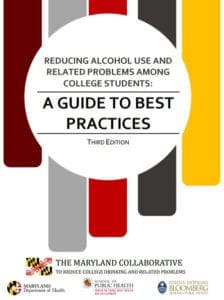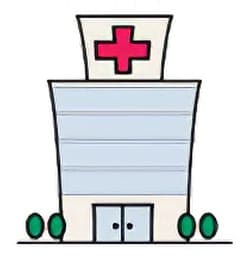Highlights: Student Engagement
1. Consult the updated Guide to Best Practices to learn more about implementation strategies for evidence based practices.
 A key takeaway is that adoption of evidence based practices is successful when we focus on the individual and environmental levels, making sure that:
A key takeaway is that adoption of evidence based practices is successful when we focus on the individual and environmental levels, making sure that:
A. Leadership is engaged,
B. Policies align with evidence based practices,
C. Training is ongoing (for clinical and nonclinical parties and community partners),
D. Stakeholders understand the value of the intervention (one of key stakeholders is students).
2. Use Social media to creatively connect and engage students with health education messages during the pandemic.
- Instagram can be successfully used by ATOD centers and health educators to hold weekly Q&A sessions.
- Peer educators at Towson are creating Tik Tok videos and asking campus partners to share them on their personal social media. Short, 60-second videos are viewed more often than longer videos. Direct students to your feed by putting your social media handle at the bottom of everything you’re doing.
- This social media platform is now a central platform for events across campus. It allows for registration and can be used for evaluation and to gather contact information so you can ask students to join your efforts.
- Hundreds of students are engaging with the posts, asking questions, and sparking conversations.
3. Use universal screening to reach students who don’t self-select to engage in Health Center social media.
 40-50 percent of the student population will visit the health center at some point. These visits are an opportunity to screen them and identify students who can be routed for outreach.
40-50 percent of the student population will visit the health center at some point. These visits are an opportunity to screen them and identify students who can be routed for outreach.
4. Involve Students with campus alcohol task forces and campus-community coalitions to implement evidence-based policy change.
- Student voices have been meaningful in campus and community task forces, assessing the physical environment, changing policies, and telling the story of alcohol and social justice.
- Including students in the planning phase often results in higher acceptance by students in strategies and policy changes.
Highlights: Student Engagement
1. Consult the updated Guide to Best Practices to learn more about implementation strategies for evidence based practices.
 A key takeaway is that adoption of evidence based practices is successful when we focus on the individual and environmental levels, making sure that:
A key takeaway is that adoption of evidence based practices is successful when we focus on the individual and environmental levels, making sure that:
A. Leadership is engaged,
B. Policies align with evidence based practices,
C. Training is ongoing (for clinical and nonclinical parties and community partners),
D. Stakeholders understand the value of the intervention (one of key stakeholders is students).
2. Use Social media to creatively connect and engage students with health education messages during the pandemic.
- Instagram can be successfully used by ATOD centers and health educators to hold weekly Q&A sessions.
- Peer educators at Towson are creating Tik Tok videos and asking campus partners to share them on their personal social media. Short, 60-second videos are viewed more often than longer videos. Direct students to your feed by putting your social media handle at the bottom of everything you’re doing.
- This social media platform is now a central platform for events across campus. It allows for registration and can be used for evaluation and to gather contact information so you can ask students to join your efforts.
- Hundreds of students are engaging with the posts, asking questions, and sparking conversations.
3. Use universal screening to reach students who don’t self-select to engage in Health Center social media.
 40-50 percent of the student population will visit the health center at some point. These visits are an opportunity to screen them and identify students who can be routed for outreach.
40-50 percent of the student population will visit the health center at some point. These visits are an opportunity to screen them and identify students who can be routed for outreach.
4. Involve Students with campus alcohol task forces and campus-community coalitions to implement evidence-based policy change.
- Student voices have been meaningful in campus and community task forces, assessing the physical environment, changing policies, and telling the story of alcohol and social justice.
- Including students in the planning phase often results in higher acceptance by students in strategies and policy changes.

 40-50 percent of the student population will visit the health center at some point. These visits are an opportunity to screen them and identify students who can be routed for outreach.
40-50 percent of the student population will visit the health center at some point. These visits are an opportunity to screen them and identify students who can be routed for outreach.